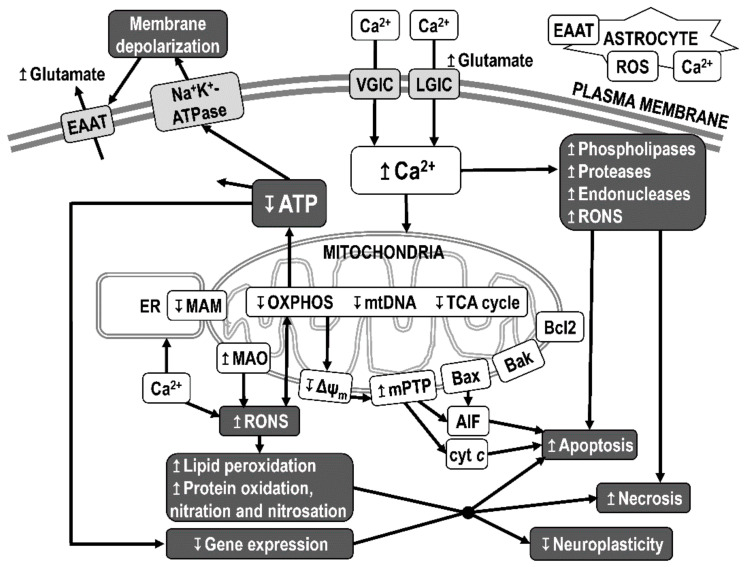Figure 6.
Mitochondrial dysfunction leading to neurodegeneration. The mitochondria-driven processes leading to neuronal damage and cell death are reduced ATP production, increased production of reactive oxygen and nitrogen species (RONS), initiation of apoptotic processes, and disturbed calcium homeostasis. Decreased ATP production leads to disruption of ATP-dependent processes, including restoration and maintenance of membrane potential. Membrane depolarization alters the function of excitatory amino acid transporters and leads to the activation of voltage-gated ion channels (VGICs) and ligand-gated calcium channels (LGICs) and to increased Ca2+ entry into the cell. Intracellular calcium acts as a second messenger for the activation of a number of cellular processes and is transported from the cytosol by ion pumps to the extracellular space, to the endoplasmic reticulum (ER), and to the mitochondrial matrix. An excessive concentration of cytosolic free Ca2+ can have a neurotoxic effect by increasing the activation of phospholipases, proteases, and endonucleases. Excessive accumulation of Ca2+ in the mitochondrial matrix causes a decrease in the membrane potential on the inner mitochondrial membrane (Δψm), a decrease in ATP production, an increase in the production of reactive oxygen species (ROS), the opening of mitochondrial permeability transition pores (mPTPs), and the release of cytochrome c (cyt c) and other pro-apoptotic factors (triggering caspase-dependent apoptosis) and of apoptosis-inducing factor (AIF) (triggering caspase-independent apoptosis). Mitochondria in the brain are also a target of nitric oxide. Bax, Bak, Bad—Bcl-2 family proapoptotic factors; Bcl-2—Bcl-2 family antiapoptotic factor; EAAT—excitatory amino acid transporter; MAM—mitochondria-associated ER membrane; MAO—monoamine oxidase.

